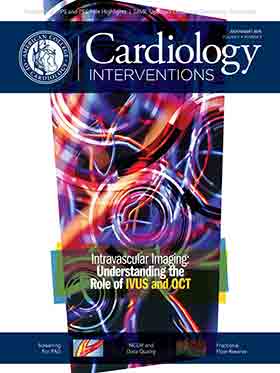Editor’s Corner | Finally FAME (ous) Too!
How quickly things change! At the Big Sky Cardiovascular Update two years ago, I discussed the results of the FAME 2 trial of fractional flow reserve (FFR)-guided PCI vs. medical therapy in 1,200 patients with stable coronary artery disease (CAD). Just to review, FFR was calculated for all target lesions in patients scheduled for PCI with a drug-eluting stent (DES) for one, two or three vessels.
Seventy-three percent of patients had at least one stenosis with an FFR ≤0.80 (n=888). These patients were then randomized 1:1 to PCI plus medical therapy or medical therapy alone. Follow-up was planned for up to five years.
FAME 2 had advantages over the COURAGE trial: 1) all target lesions were deemed ischemia-causing as measured by FFR; 2) DES were used, not bare metal stents; 3) medical therapy was delivered “real world” style, by clinicians without designated case managers.
Up until the Big Sky meeting, the conclusions were still controversial in that “hard” endpoints such as myocardial infarction (MI) or cardiac death did not reach statistical significance. Nonetheless, it was fair at that point to state that FAME 2 showed that in patients with stable CAD, FFR-guided PCI improved combined patient outcomes vs. medical therapy alone.
This improvement was driven by a large decrease in the need for urgent revascularization for acute coronary syndromes. Importantly, in patients with functionally nonsignificant stenosis, medical therapy alone resulted in an excellent outcome, regardless of the angiographic appearance of the stenoses.
More FAME 2 Data, Pooled Analysis
Now, from EuroPCR 2018, we have five-year follow-up from FAME 2 that eclipses all those conclusions with the “hard” endpoint of MI. In short, we can state that in patients with stable CAD, when compared with medical therapy, FFR-guided PCI:
- Decreases the need for urgent revascularization
- Decreases the rate of spontaneous MI
- Improves symptomatic relief
Kudos to the investigators for following through to the prescribed endpoint and finally showing the merits of FFR-guided PCI. We tend to forget that CAD is a slowly progressive disease in many instances, and it may take a long time (five years) to produce hard endpoints.
But there’s more from EuroPCR that supports these data. Because of the ongoing controversy of the role of PCI in stable ischemic heart disease, and because other randomized trials had insufficient power for hard endpoint analysis, other investigators performed a pooled patient-level analysis of FFR-guided PCI vs. medical therapy from three randomized trials: FAME 2, DANAMI-3-PRIMULTI and COMPARE-ACUTE.
The pooled analysis asked a simple question: Does FFR-guided PCI reduce cardiac death and MI compared with medical therapy in the combined group of 2,400 patients? Each trial (until then) demonstrated a clinical benefit in favor of FFR-guided PCI. But all, as mentioned, were driven by urgent revascularization in the primary endpoint. Each trial by itself was not powered for the endpoint of cardiac death or MI.
The pooled analysis showed that PCI, guided by FFR, reduces the composite outcome of cardiac death or MI compared with an initial strategy using medical therapy. The investigators also found a relative risk reduction of approximately 30 percent when using FFR-guided treatment, which corresponded to an estimated absolute risk reduction of about 4.5 percent at five years. In addition, analyses also favored FFR-guided PCI for the composite of all-cause death or MI. In this analysis, the differences between groups were driven by a reduction in MI.
FFR: Questions Remain, The Future
For interventional cardiologists, this news from EuroPCR is not surprising. The use of FFR to evaluate whether a lesion can produce ischemia downstream has become routine. FFR is especially helpful for “borderline” coronary lesions when an FFR <0.80 supports performing a PCI and gives credence to operators facing quality review when ischemia may be difficult to demonstrate objectively.
This, of course, raises other issues. Does an FFR <0.80 always define an ischemic lesion? Is that yardstick correct? Would we be better served using a lower or even perhaps a higher number to support an intervention? Lesion instability is not measured by FFR.
What should be done about a clinical situation in which a lesion is seemingly clinically “unstable” but the FFR is 0.82? If this lesion is in the proximal left anterior descending coronary artery, would you do a PCI? What about the long, 40-50 percent lesion with an FFR 0.78? We may now be comfortable with what we all anticipated: FFR-guided PCI is associated with long-term “hard” endpoints. This is indeed comforting, but we still have much to learn about the difficult decisions.
And finally, let me take a quick peek into what the future may hold. Yogi Berra is famously purported to have said it’s difficult to make predictions — especially about the future. So, I’ll be cautious. At the same EuroPCR 2018, Collet and colleagues reported on a large study of FFR derived from computed tomographic angiography in patients with multivessel coronary disease.1
In this study, clinical decisions were made not on FFR derived from intracoronary intervention, but from FFR as computed by entirely noninvasive means. We may know now that FFR-guided PCI is supported by hard clinical outcomes. But we may in the future relinquish the computation of FFR to our imaging colleagues. Stay tuned. The next issue of Cardiology: Interventions will examine this issue in detail.

Peter C. Block, MD, FACC, is a professor of medicine and cardiology at Emory University Hospital and School of Medicine in Atlanta, GA.
Reference
- Collet C, Miyazaki Y, Ryan N, et al. J Am Coll Cardiol 2018;71:2756-69.
Clinical Topics: Invasive Cardiovascular Angiography and Intervention, Atherosclerotic Disease (CAD/PAD), Interventions and Coronary Artery Disease
Keywords: ACC Publications, Cardiology Interventions, Drug-Eluting Stents, Coronary Artery Disease, Cost-Benefit Analysis, Case Management, Follow-Up Studies, Percutaneous Coronary Intervention
< Back to Listings

